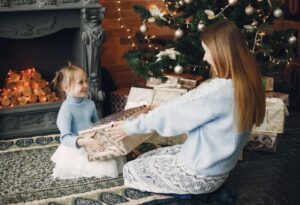Holiday Gift Guide: A Play Therapist Perspective

The stores are decorated, sales are on, and the holiday season is in full swing. I don’t know about you, but this time of year I often find myself pulling out paper and pen to make a gift list and drawing a blank. Then all the questions begin… I keep seeing the “hottest” toys this season everywhere I look, should I just go with the most popular toys? What about educational toys? Is this promoting diversity in my house? So we pulled together a holiday gift guide from a play therapist perspective that will help to promote social and emotional development, improve attachment, imagination and creativity, and overall well-being.
Open-Ended Toys Verses Electronic Toys
For a child, play is purposeful and free play with open-ended toys is the richest type of play. According to Landreth (2002), Play relieves feelings of stress and boredom, builds positive connections with others, promotes creative thinking and exploration, regulates our emotions, and boosts our ego. Open-ended toys require children to use their imagination and allow their emotions to come out through their play. While battery operated toys are meant to be used in a specific way; which are restrictive, overstimulating, and take away from the child-led free expression. Not to mention, who wants to buy a bunch of batteries this holiday season. In play therapy, toys are carefully selected from different categories that all have evidenced-based therapeutic benefits. Below we provide a few of these categories, their benefits, and some ideas to add to your holiday gift list.
- Family/Nurturing: Children love to mimic the adults in their lives. Toys within this category give children the opportunity to play out adult roles, particularly within the family system (Ray, 2011). Multicultural dolls are a great way to teach children about acceptance. Through this type of play, children build a sense of autonomy, independence, relationship building, and empathy towards others.

-
- Dollhouse, multicultural family figurines, and furnitureBaby dolls and accessories
- Multicultural dolls
- Toy vacuum/ Toy cleaning supplies
- Stuffed toys, blankets, crib
- Play kitchen, accessories, and play food

- Mastery: Although many of these toys do not find themselves in a therapeutic play room, there is certainly a place for them within the home. Therefore, we have included this category in the list. Mastery toys are toys that allow children to try out new skills, to build a sense of capability, encouragement, improve frustration tolerance, and build self esteem.
- Blocks/legos
- Puzzles
- Magnatiles
- Pikler triangle
- Trampoline
- Stepping stones
- Balance beam

- Expressive: Toys within this category typically include arts and crafts materials that promote creative expression, which allow children to express both positive and negative emotions (Ray, 2011). Among this list, we have also included sensory play materials. Through expressive play, children build self-control, emotional regulation, and creativity.
- Paints, crayons, colored pencils, markers
- Construction paper
- Coloring books
- Play dough
- Pop bead set/beads
- Stickers
- Water beads
- Slime materials
- Kinetic sand

- Pretend/Fantasy: Toys that fall within this category allow for children to try out different roles. Typically this would include dress up clothes, medical kits, puppets and pretend play items that allow for children to deeply explore the adult world in a safe environment (Ray, 2011). In the era of COVID, many children could benefit from having a medical kit to play out fears related to the doctors and vaccinations. This is another great place to include different cultural items to build diversity.
- Dress up
- Mask
- Medical kit
- Telephone
- Puppets
- Animal figurines
- Play couch (doubles as comfort, and when used as a fort, containment)
- Magic wand
- Knights, castles
- Transportation toys/community helpers
This list is a compilation of ideas based on evidenced-based play therapy, sprinkled in with some parent tested and kid approved ideas. It is not an exhaustive list, but rather a place to gather ideas that help stimulate a child’s social and emotional well-being.
Now maybe you are looking at the above list and thinking, ok our house is stock full of these types of toys and they rarely get played with when the electronic toys are so enticing. One way to freshen up their appeal is put a selection away and have them come out once a week for 30 minutes of special play time with your child. Make an invitation or appointment card that you leave in your child’s stocking introducing this idea. During this time, the child will take the lead and you will follow. Limit questions and track their play, reflect feelings, and return responsibility by avoiding teaching moments. This helps build attachment and bonding relationships.
…or maybe you are looking for something different this year other than adding more toys. Consider family outings, activities, and season passes as a way to build family relations and lasting memories. Remember, the real spirit of giving comes from the time and love we share with others.
Happy Holidays,
Crossroads Family Counseling Center Team
About the Author: Michelle Walker is a Licensed Clinical Social Worker and Registered Play Therapist practicing at Crossroads Family Counseling Center. Michelle has been working in the field for over 10 years and specializes in Early Childhood Mental Health.
References:
Landreth, G. (2002). Play therapy: The art of the relationship (2nd ed.). New York City, NY: Routledge.
Ray, D (2011). Advanced Play Therapy. New York City, NY: Routledge.
